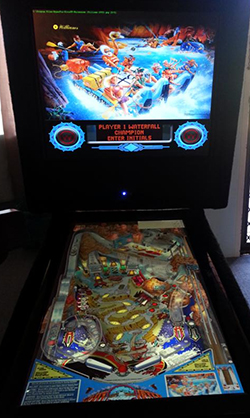Building a MAME machine – an arcade cabinet that will play everything from Galaga to Street Fighter II – is surely on the ‘to build’ list of thousands of Hackaday readers around the world. It’s a relatively simple build, provided you can put a sheet of MDF in your car; it’s just an emulator, and if you can find a CRT and have an old computer sitting around, you’re already halfway there.
There is another class of arcade games that can be emulated. This is, of course, pinball machines. [Jan] built a virtual pinball cabinet over the last few months and his build log is incredible. If you’ve ever wanted to build a pinball emulator, this is the guide to reference.
The most important part of a pinball emulator is the displays. For this, [Jan] is using a 40-inch TV for the playfield, a 28-inch monitor to display the backglass art, and a traditional 128×32 DMD. Instead of manufacturing his own cabinet, he repurposed an old electromechanical machine, Bally’s Little Joe.
The software is the real star of the show with PinballX serving as the front end, with Future Pinball and Visual Pinball serving as the emulators. These emulators drive the displays, changing out back glasses, and simulating the physics of the ball. The computer running all of this has a few neat electromechanical bits including a shaker motor, an original Williams replay knocker, and some relays or solenoids give the digital table a tremendous amount of force feedback. This is the way to do it, and if you don’t have these electromechanical bits and bobs securely fastened to the machine, you really lose immersion.
You can check out a video of the table in action below.


 Hang around Hackaday long enough and you’ll hear about MAME, and all the other ways to emulate vintage arcade machines on a computer. The builds are usually fantastic, with real arcade buttons, MDF cabinets, and side graphics with just the right retro flair to make any connoisseur of ancient video games happy. MAME is only emulating old video games, though, and not physical systems like the
Hang around Hackaday long enough and you’ll hear about MAME, and all the other ways to emulate vintage arcade machines on a computer. The builds are usually fantastic, with real arcade buttons, MDF cabinets, and side graphics with just the right retro flair to make any connoisseur of ancient video games happy. MAME is only emulating old video games, though, and not physical systems like the 
 The neon dot matrix displays in pinball machines of this era are finicky devices with a lot of stuff that can go wrong. On powering the display up, [Quinn] noticed a few columns on the left side of the display weren’t working. These machines have great diagnostic menus, so running a test that displays a single column at a time revealed two broken columns. However, when a solid fill test was run, all the columns work, save for a few dots in the upper left corner. This is an odd problem to troubleshoot, but after more tests [Quinn] realized dots in column five and six only work iff both adjacent dots in the same row are lit.
The neon dot matrix displays in pinball machines of this era are finicky devices with a lot of stuff that can go wrong. On powering the display up, [Quinn] noticed a few columns on the left side of the display weren’t working. These machines have great diagnostic menus, so running a test that displays a single column at a time revealed two broken columns. However, when a solid fill test was run, all the columns work, save for a few dots in the upper left corner. This is an odd problem to troubleshoot, but after more tests [Quinn] realized dots in column five and six only work iff both adjacent dots in the same row are lit.









